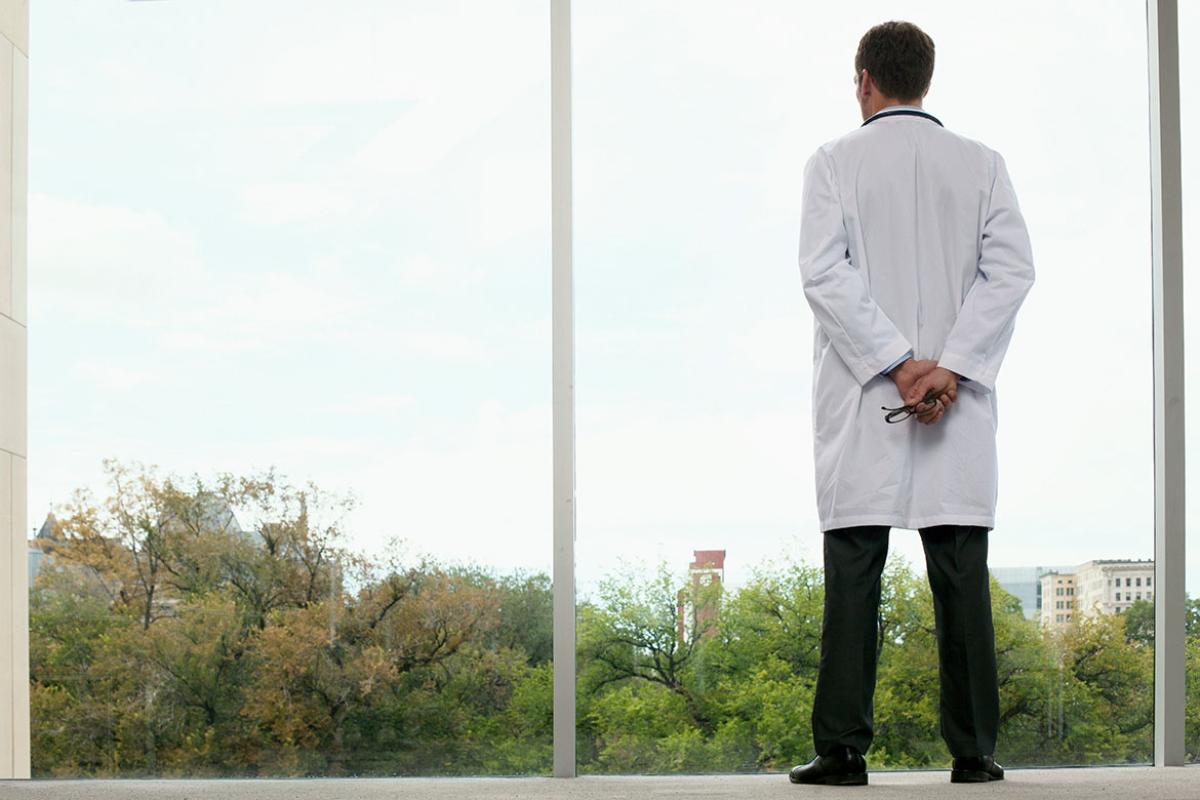In a bold stride toward transforming cancer treatment, James Byrne, MD, an assistant professor of radiation oncology at University of Iowa Health Care, has received the prestigious 2024 National Institutes of Health (NIH) Director’s New Innovator Award. The five-year, $1.5 million grant will further Dr. Byrne’s groundbreaking work in improving outcomes and quality of life for patients with cancer undergoing radiation therapy.
“Cancer affects a huge number of patients, and although treatment options have improved significantly for many cancers, therapies can still fall short, and they can come with harsh side effects that are difficult to tolerate,” said Dr. Byrne, a radiation oncologist in Iowa City, Iowa. “Our goal in developing these novel materials is to address these challenges and develop promising new ways to improve treatment for many different types of cancer.”
University of Iowa Health Care is a member of the AMA Health System Program, which provides enterprise solutions to equip leadership, physicians and care teams with resources to help drive the future of medicine.
His work at the intersection of engineering, cancer biology and patient care is designed to reduce the harmful side effects of radiation therapy. He is exploring how to harness the molecular defense mechanisms of species such as yeti crabs, which survive the intense heat and pressure of deep-sea hydrothermal vents, and tardigrades, microscopic creatures renowned for withstanding staggeringly massive doses of radiation.
“These awards are incredibly competitive, so I feel fortunate to have received it. I’m especially excited because the award allows us to pursue bold, high-risk, high-reward projects that typical funding mechanisms often can't support,” Dr. Byrne said. “This gives us a chance to explore uncharted territory in cancer research that could have a profound impact.
“Being one of only 40 early-career investigators selected across the nation was both humbling and motivating,” he added. “The recognition validates not just the science—it also supports its potential to improve patients' lives.”
The award will support Dr. Byrne’s work developing biocompatible materials to reduce side effects of radiation therapy. His research is supported by the NIH Common Fund, the Prostate Cancer Foundation, the Department of Defense, the American Cancer Society and other organizations committed to advancing cancer care through bold, innovative science.
In an interview with the AMA, Dr. Byrne discussed receiving the award, what inspires his work and his next steps in cancer research.
AMA: What is the central idea behind your award-winning research?
Dr. Byrne: The core of our research is developing ways to protect healthy tissue from the damaging side effects of radiation therapy, but without compromising radiation’s ability to destroy tumors.
Radiation is a powerful tool in cancer treatment, but it often harms nearby normal tissues. We’re working on a solution inspired by nature: using messenger RNA to deliver protective proteins to vulnerable cells.
In particular, we’ve focused on a protein called Dsup, which shields DNA from radiation damage. We’ve seen promising results in preclinical models by engineering nanoparticles to deliver mRNA that prompts cells to produce Dsup.
Healthy tissue remains protected while tumors still respond to treatment. That’s the balance we seek—to preserve the therapeutic power of radiation while dramatically improving its safety.
AMA: What inspired you to look to tardigrades for solutions in cancer therapy?
Dr. Byrne: They are a fascinating example of how studying nature’s outliers can lead to innovations in medicine. Tardigrades, sometimes called “water bears,” are microscopic organisms that are almost unimaginably hardy. They are capable of surviving space travel, extreme dehydration and radiation doses thousands of times higher than what humans can tolerate.
One reason they can do this is that they produce Dsup, a protein that protects DNA from radiation damage, and that sparked our interest. We wondered, if tardigrades can survive radiation using natural molecular tools, could we adapt those same tools to help human cells endure cancer treatments?
AMA: What do you think makes your approach stand out in the field of cancer research?
Dr. Byrne: The interdisciplinary nature of our work. We combine biomedical engineering with cancer biology, which allows us to look at problems in novel ways. For example, some of our research draws on molecular gastronomy—the same culinary science behind foams and gels—to develop materials that carry and release oxygen into tumors.
We use whipped cream siphons to create injectable foams that deliver gases like oxygen directly to tumor sites, enhancing radiation and chemotherapy. The beauty is in the simplicity. Using intuitive and widely available tools lowers the barrier for translation into clinical settings. We also follow the KISS principle—keep it simple, stupid. That’s our guiding philosophy.
AMA: Tell our readers more about these oxygen-releasing materials.
Dr. Byrne: A common feature in many aggressive cancers is tumors with low oxygen levels, which make radiation less effective. We’ve developed gas-entrapping materials, or GEMs, in the form of foams, gels and solids that deliver therapeutic gases like oxygen or nitric oxide directly into tumor tissue.
Boosting oxygen levels locally makes the tumors more sensitive to treatment. We’ve also adapted these materials for wound healing in diabetic skin ulcers, where they improve tissue regeneration. It’s a versatile platform that grew from asking simple questions with broad implications.
AMA: What role has collaboration played in your research?
Dr. Byrne: It’s everything. This work wouldn’t be possible without the support of some incredible partners, including Gio Traverso, PhD, and Bob Langer, DSc, at MIT, and Leo Otterbein, PhD, at Beth Israel Deaconess. Marine biologists at University of North Carolina Wilmington, particularly Mike Tift, PhD, helped us expand some of our research into new areas, and we’ve had outstanding support, mentorship, infrastructure and a collaborative clinical environment here at the University of Iowa. Everyone is invested in moving this work from the lab to patients.
AMA: What’s next for your team?
Dr. Byrne: A Phase 1 clinical trial that tests a therapy that delivers oxygen to sarcoma tumors during radiation. If it’s successful, the trial will demonstrate that we can safely and feasibly enhance tumor oxygenation, which could significantly improve patient outcomes.
We’re also expanding our RNA therapy platform to include other proteins that might protect tissues or sensitize tumors. And we’re working on additional devices that merge engineering principles with clinical needs. It’s a really exciting time!
AMA: What are other challenges in radiation oncology right now?
Dr. Byrne: One is determining where radiation fits within the evolving landscape of cancer therapy. We’ve seen explosive growth in immunotherapy and CAR T-cell therapy, and radiation must find its place in these multimodal approaches. Even successful radiation treatment can leave patients with long-term side effects that affect their quality of life. Our research addresses how to enhance effectiveness while reducing toxicity.
AMA: How can this research change patient care?
Dr. Byrne: Making radiation therapy safer and more targeted means that patients would no longer have to choose between curing their cancer and quality of life. Protecting healthy tissues or reducing the dose needed to treat a tumor will fundamentally improve the standard of care.
I see a future where treatments are tailored not just to the tumor’s biology but also to each patient’s ability to tolerate therapy. They’ll not just survive cancer but live well after treatment.
AMA: What advice do you have for aspiring physician-scientists or early-stage researchers?
Dr. Byrne: Know that rejection is part of the job. Everyone deals with it. Just be resilient and believe in your vision. Surround yourself with people who lift you up and challenge your thinking.
Don’t be afraid to pursue an idea that feels a little out there because “out there” is where innovation happens. And most importantly, keep the patient at the center. At the end of the day, that’s who we’re doing this for.





